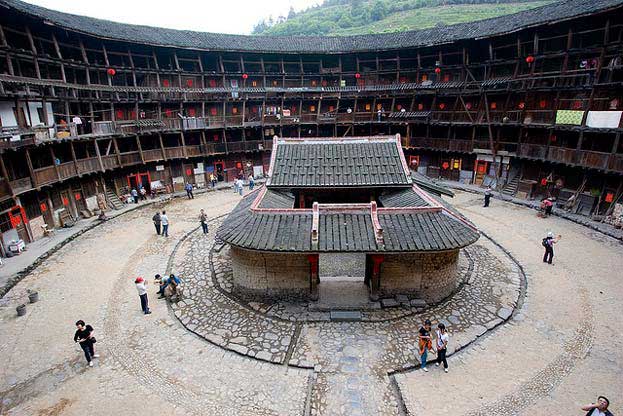The famous tulou, which has put Hakka architecture and culture on the world map when a cluster of the homes in Fujian province was inscribed in 2008 by Unesco as a World Heritage Site, is now a new landmark in the ancient town of Luodai in Sichuan province. AT first sight, the earthen building in the ancient town of Luodai, about 20km from Chengdu in Sichuan province, looks like the historical tulou dwelling of the Hakka community in Fujian province. The famous tulou has put Hakka architecture and culture on the world map when a cluster of 46 tulou homes scattered over 120km in the province was inscribed in 2008 by Unesco as World Heritage Site for its unique architecture and function of communal living and defensive organisation.
Want to read UNESCO Daily News Updates? Click Here!!!
Enclosed Fortified Circular Shaped Building
 An enclosed and fortified building circular in shape, a tulou scales up to five-storeys housing about 80 families of the same clan. Behind the peripheral walls are halls, storerooms, wells and residential homes forming a smaller city within the fortified structures. Many of the tulou homes have been in existence for more than 700 years. Instead of being a residence, the earthen building at Luodai is home to a centre for the promotion and conservation of various Chinese folk arts and a Hakka culture museum.
An enclosed and fortified building circular in shape, a tulou scales up to five-storeys housing about 80 families of the same clan. Behind the peripheral walls are halls, storerooms, wells and residential homes forming a smaller city within the fortified structures. Many of the tulou homes have been in existence for more than 700 years. Instead of being a residence, the earthen building at Luodai is home to a centre for the promotion and conservation of various Chinese folk arts and a Hakka culture museum.It has become a new landmark, accentuating the rich cultural history of the Hakka community which moved to the area from Fujian, Guangdong, Jiangxi, Hubei and Hunan provinces hundreds of years ago. "This is a new building completed in April. It was copied from the tulou cluster in Fujian to symbolise the presence of our community in this town," said Zhang Longfeng, who is of Hakka descent.
"Historically, there are no tulou homes in this area, but we do preserve some traditional Fujian buildings that still can be found in the streets of the town." Among the heritage buildings left are the Guangdong, Jiangxi, Hubei-Hunan and Northern Sichuan guild halls dating back to the Qing dynasty, a traditional school and several courtyard houses with an open area in the middle and main buildings decorated with turtle and flower carvings.
 |
| Circular Building Interior View |
The company's deputy general manager, Feng Wei, said the tulou architecture was unique to the Hakka ethnic minority group. "The Hakka people were outsiders and a migratory community. When they arrived at a new place, they worried that they would be threatened by the local people.
"So, they built this kind of enclosed home with only a few door and window openings. Some of the windows were even used as gun holes to shoot at enemies who attacked them," he said. He said some three to four million tourists visited the town every year because of its scenery and cultural heritage, and the tulou project plays a significant role in promoting the Hakka culture.
Since the opening of the building in the middle of the year, the local government has organised cultural events such as the Hakka cuisine festival and the Hakka water splashing festival. "Previously, many Hakka people lived in the traditional courtyard houses in the ancient town. The houses were built in a way that the front was a shop with the courtyard and residence located at the rear, said Zhang.
"Riding on the tourism boom, residents rented out their properties to traders and operators who turn the premises into galleries and restaurants," she said. Zhang said many residents then moved out and built new homes or bought apartments outside the tourist belt.
She said some residents remained as farmers and enjoyed good harvests of honey peaches and other fruits. "We have preserved our Hakka culture and customs for generations. We speak the same Hakka dialect as our compatriots in Fujian and Guangdong provinces with perhaps a slight difference in pronunciation.
"Besides Hakka, we also learned to speak Sichuan dialect from the Sichuan people," she added. According to historical records, during the later years of the Northern Song and Southern Song dynasties (1127-1279), the conquest of northern China by the Jin ethnic forces forced many Han Chinese in central China to move southward, bringing with them the language and culture to form the Hakka group.









No comments:
Post a Comment